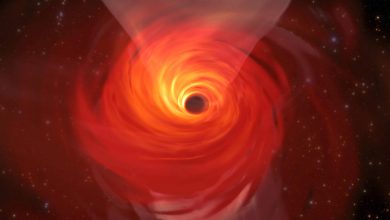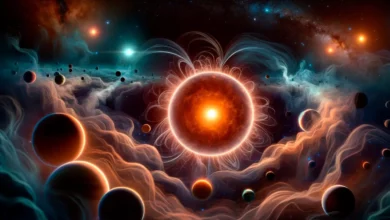
Lead Image: Scientists have discovered a unique binary system 1,400 light years away that consists of a hot Jupiter-like object orbiting a white dwarf, offering unparalleled insights into the study of hot Jupiters and the evolution of stars in binary systems. The hot Jupiter-like object, which orbits a star 10,000 times fainter than typical stars, has extreme temperature variations and provides a glimpse into the effects of intense ultraviolet radiation on planetary atmospheres.
A newly discovered binary celestial system could advance our understanding of planet and star evolution under extreme conditions
The search for exoplanets – planets that orbit stars located beyond the borders of our solar system – is a hot topic in astrophysics. Of the various types of exoplanets, one is hot in the literal sense: hot Jupiters, a class of exoplanets that are physically similar to the gas giant planet Jupiter from our own neighborhood.
Unlike “our” Jupiter, hot Jupiters orbit very close to their stars, complete a full orbit in just a few days or even hours, and – as their name suggests – have extremely high surface temperatures. They hold great fascination for the astrophysics community. However, they are difficult to study because the glare from the nearby star makes them hard to detect.
Now, in a study recently published in the journal Nature Astronomy, scientists report the discovery of a system consisting of two celestial bodies, located about 1,400 light years away, that, together, offer an excellent opportunity for studying hot Jupiter atmospheres, as well as for advancing our understanding of planetary and stellar evolution. The discovery of this binary system – the most extreme of its kind known so far in terms of temperature – was made through analysis of spectroscopic data gathered by the European Southern Observatory’s Very Large Telescope in Chile.
“We’ve identified a star-orbiting hot Jupiter-like object that is the hottest ever found, about 2,000 degrees hotter than the surface of the Sun,” says lead author of the study Dr. Na’ama Hallakoun, a postdoctoral fellow associated with Dr. Sagi Ben-Ami’s team in the Particle Physics and Astrophysics Department at the Weizmann Institute of Science. She adds that, unlike glare-obscured hot-Jupiter planets, it is possible to see and study this object because it is very large compared to the host star it orbits, which is 10,000 times fainter than a normal star. “This makes it a perfect laboratory for future studies of hot Jupiters’ extreme conditions,” she says.
An extension of research she conducted in 2017 with Prof. Dan Maoz, her Ph.D. advisor at Tel Aviv University, Hallakoun’s new discovery may make it possible to gain a clearer understanding of hot Jupiters, as well as of the evolution of stars in binary systems.
Massive brown dwarf with a “Moon-like” orientation
The binary system that Hallakoun and colleagues discovered involves two celestial objects that are both called “dwarfs,” but that are very different in nature. One is a “white dwarf,” the remnant of a Sun-like star after it has depleted its nuclear fuel. The other part of the pair, not a planet or a star, is a “brown dwarf” – a member of a class of objects that have a mass between that of a gas giant like Jupiter and a small star.
Brown dwarfs are sometimes called failed stars because they are not massive enough to power hydrogen fusion reactions. However, unlike gas giant planets, brown dwarfs are massive enough to survive the “pull” of their stellar partners.
“Stars’ gravity can cause objects that get too close to break apart, but this brown dwarf is dense, with 80 times the mass of Jupiter squeezed into the size of Jupiter,” Hallakoun says. “This allows it to survive intact and form a stable, binary system.”
When a planet orbits very close to its star, the differential forces of gravity acting on the near and far side of the planet can cause the planet’s orbital and rotational periods to become synchronized. This phenomenon, called “tidal locking,” permanently locks one side of the planet in a position that faces the star, similarly to how Earth’s Moon always faces Earth, while its so-called “dark side” remains out of sight. Tidal locking leads to extreme temperature differences between the “dayside” hemisphere bombarded by direct stellar radiation and the other, outward-facing “nightside” hemisphere, which receives a much smaller amount of radiation.
The intense radiation from their stars causes hot Jupiters’ extremely high surface temperatures, and the calculations Hallakoun and her colleagues made about the paired white dwarf-brown dwarf system show just how hot things can get. Analyzing the brightness of the light emitted by the system, they were able to determine the orbiting brown dwarf’s surface temperature in both hemispheres. The dayside, they discovered, has a temperature of between 7,250 and 9,800 Kelvin (about 7,000 and 9,500 Celsius), which is as hot as an A-type star – Sun-like stars that can be twice as massive as the Sun – and hotter than any known giant planet. The temperature of the nightside, on the other hand, is between 1,300 and 3,000 Kelvin (about 1,000 and 2,700 Celsius), resulting in an extreme temperature difference of about 6,000 degrees between the two hemispheres.
A rare glimpse into an unexplored region
Hallakoun says that the system she and her colleagues discovered offers an opportunity to study the effect of extreme ultraviolet radiation on planetary atmospheres. Such radiation plays an important role in a variety of astrophysical environments, from star-forming regions, through primordial gas discs from which planets are formed around stars, to the atmospheres of planets themselves. This intense radiation, which can lead to gas evaporation and the breaking of molecules, can have a significant impact on both stellar and planetary evolution. But that’s not all.
“Merely one million years since the formation of the white dwarf in this system – a minuscule amount of a time on the astronomical scale – we have gotten a rare glimpse into the early days of this kind of compact binary system,” Hallakoun says. She adds that, while the evolution of single stars is fairly well known, the evolution of interacting binary systems is still poorly understood.
“Hot Jupiters are the antithesis of habitable planets – they are dramatically inhospitable places for life,” Hallakoun says. “Future high-resolution spectroscopic observations of this hot Jupiter-like system – ideally made with NASA’s new James Webb Space Telescope – may reveal how hot, highly irradiated conditions impact atmospheric structure, something that could help us understand exoplanets elsewhere in the universe.”
Reference: “An irradiated-Jupiter analogue hotter than the Sun” by Na’ama Hallakoun, Dan Maoz, Alina G. Istrate, Carles Badenes, Elmé Breedt, Boris T. Gänsicke, Saurabh W. Jha, Bruno Leibundgut, Filippo Mannucci, Thomas R. Marsh, Gijs Nelemans, Ferdinando Patat and Alberto Rebassa-Mansergas, 14 August 2023, Nature Astronomy.
DOI: 10.1038/s41550-023-02048-z
Study participants also included Prof. Dan Maoz of Tel Aviv University; Dr. Alina G. Istrate and Prof. Gijs Nelemans of Radboud University, the Netherlands; Prof. Carles Badenes of the University of Pittsburgh; Dr. Elmé Breedt of the University of Cambridge; Prof. Boris T. Gänsicke and the late Prof. Thomas R. Marsh of the University of Warwick; Prof. Saurabh W. Jha of Rutgers University; Prof. Bruno Leibundgut and Dr. Ferdinando Patat of the European Southern Observatory; Dr. Filippo Mannucci of the Italian National Institute for Astrophysics (INAF); and Prof. Alberto Rebassa-Mansergas of Polytechnic University of Catalonia.
Dr. Sagi Ben-Ami’s research is supported by the Peter and Patricia Gruber Award; the Azrieli Foundation; the André Deloro Institute for Advanced Research in Space and Optics; and the Willner Family Leadership Institute for the Weizmann Institute of Science.
Dr. Ben-Ami is the incumbent of the Aryeh and Ido Dissentshik Career Development Chair.





